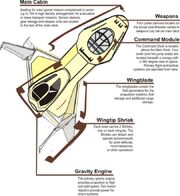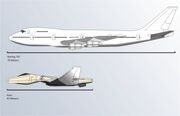Aves are the primary transport craft used to support the Odyssey Mission. They are carried on board ships of the Pathfinder series, where they also provide offensive and defensive capabilities.
Development[]
The Aves were developed and produced for the Odyssey Project by CloudBuster Avian, the Sapphirean Aerospace company. They were based on the M1 shuttlecraft used by the Sapphirean Military for transit between the Sapphire and Republic systems at high sub-light. They were enhanced specifically for the Odyssey Mission:
- The Addition of Shrieks (Accipiters) for long-range defense, surveillance, and reconnaissance
- Enhanced shields and weapons systems
- Triple Redundancy on key systems.
- All Environment capability for operations in space, atmosphere, underwater, and a wide range of other environments
- Propulsion system and Quantum Reactor upgrades for fast sustained flight.
- Additional speed and agility for tactical operations.
Upgrades
- The Aves Mark II Upgrade enhances the capabilities of the ship's navigation, control, and cyber-intelligence systems. This upgrade was integrated into the Aves of Pathfinder 3 Pegasus when it stopped at the Chapultepec Starlock. (Book 5: Aurora )
Successors[]
The Aves were succeeded, after Mark VII, by the Aquilae and Novaaves series
- Aquilae are one-third larger and have dual engines. Aquilae possess less armament and are slower and less maneuverable than Aves. (Book 11: Charlemagne ) Aquilae replaced Aves on Explorer and Defender Class ships, as well as on space stations including Starlocks.
- Nova Aves are 40% smaller than Aves and possess a single powerplant and few armaments. They have a diminished cargo capacity relative to Aves and are used primary as personnel shuttles.

This diagram sucks
Structure[]
An Aves has three decks - the Command Deck (located in the forepart of the ship beneath the canopy), the Main Deck, which runs the length of the ship, and a cargo deck below the Main deck and under the wingblades. An engineering section occupies the rear of the ship, which contains both the Graviton Engine and the Quantum Reaction that powers it.
Controls[]
Aves use direct neural links to interface with their pilots; the pilot's brain is connected directly to the ship's Artificial Intelligence (AI) braincore. This interfaces appears in the form of a small electronic "ridge" that appears on the pilot's face, which is constructed by nanites contained in his bloodstream. Pilots usually have an implant in the form of an artificial bone (usually in the forearm) where the nanites are produced, housed, and disposed of.
The physical controls on the command deck are customizable to the pilot; who can use, for example, a yoke, a joystick, a panel, or whatever mode of physical interface is most efficient to him. Unlike Accipiters, which use a saddle-seat, the pilot of an Aves sits upright.
Weapons[]
- Twin Ion Cannons on the front of the ship, forward of the Main Deck
- Two Ion Cannons, one located on each wingblade.
- One aft Ion Cannon on the rear of the ship.
- Up to 24 Hammerhead missiles can be carried in the forward, port, and starboard weapons bay.
- Graviton-generated forcefields to protect the ship from energy and kinetic weapons.
Fuel[]
Tritium is used to initiate the subatomic reactions in the Quantum Reactor. Once the reaction is initiated, an Aves has virtually unlimited access to Zero Point Energy.
Propulsion[]
Aves use a standard Graviton Engine for propulsion in space, which accelerates the ship using systolic motion in space-time (compressing space-time behind the ship to accelerate it forward through means of a short-range pseudo-gravity field). The ship also has ion-jets housed in "thruster clusters" on its foreward, aft, port, starboard, dorsal, and ventral points for maneuvering.
Speed[]
Aves can handle velocities in excess of .9c (Ninety percent of the speed of light)
Size and Scale[]
An Aves is 42 Meters Long and can carry up to 200 passengers when outfitted for maximum density.

Deployment[]
A Pathfinder Ship Carries a standard complement of 178 Aves.
- 84 are maintained on Active Duty, divided into four Flight Groups
- 32 are maintained in Reserve, ready for duty on short notice
- 62 are held in the cargo bay in a disassembled state, ready to replace ship's lost in the course of duty.
Naming[]
Most Aves are given simple names to designate them. Each Pathfunder Ship followed a different naming convention.
- Aves on board Pegasus were given human names, Amy, Basil, Chloe, and so forth.
- Aves on board Lexington Keeler were given the names of human attributes; Ambition, Brave, Courage and so forth